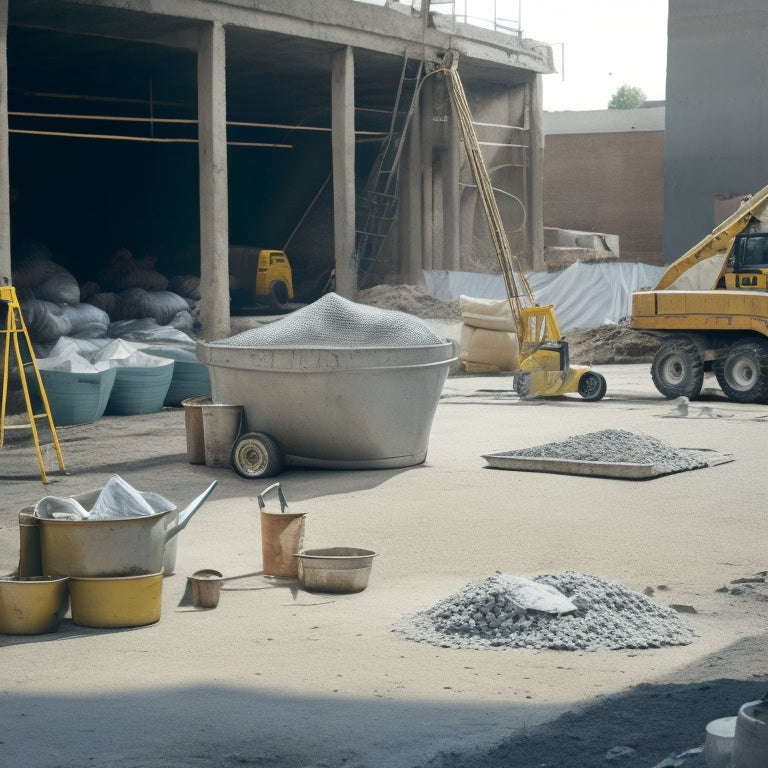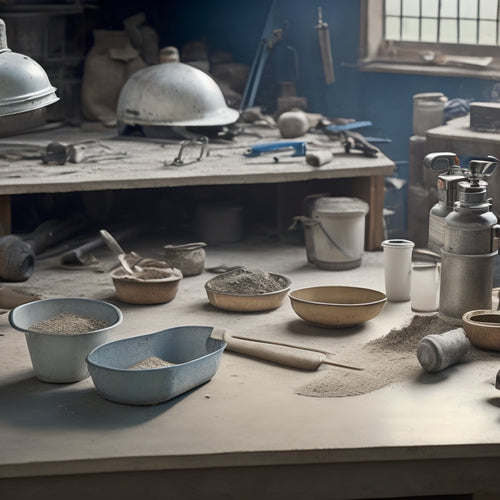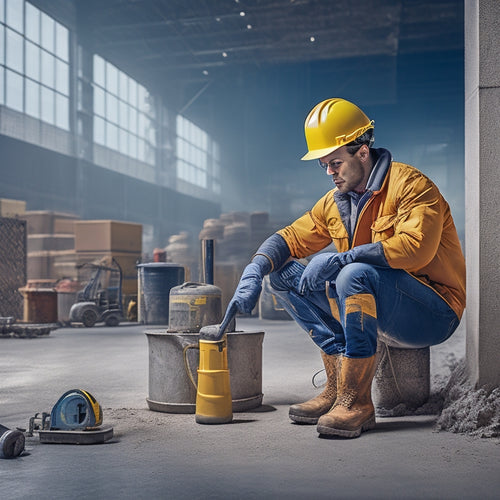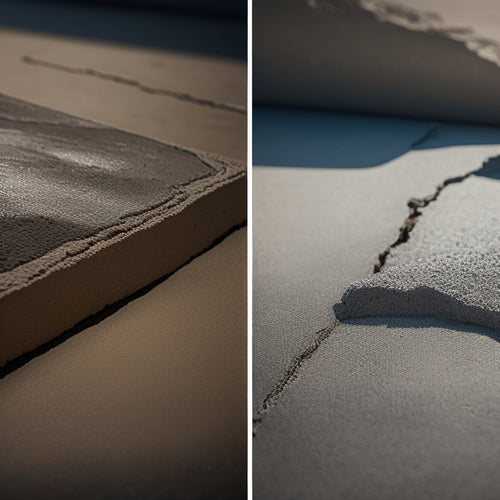
5 Best Tools for Mixing Concrete by Hand
Share
When mixing concrete by hand, you'll need the right tools to get the job done efficiently and safely. Start with a heavy-duty mixing bucket featuring a comfortable handle, flat bottom, and sufficient capacity for your project. A concrete mixing paddle, available in square-edged and rounded-edged designs, helps to achieve the right consistency. Add a hand tamper and level for finishing, and don't forget measuring containers, pouring tools, and essential safety gear like gloves, goggles, and a dust mask. With these top 5 tools, you'll be well-equipped to tackle your concrete project - and discover the finer points of getting it just right.
Key Takeaways
• A heavy-duty mixing bucket with a non-slip handle and flat bottom is essential for safe and efficient concrete mixing.
• A hand tamper or tamping rod is necessary for eliminating air pockets and ensuring even concrete distribution.
• A concrete mixing paddle with an ergonomic design and suitable edge type (square or rounded) helps reduce user fatigue and achieves the right mix.
• Reliable measuring containers with clear markings are crucial for accurate proportions of cement, sand, and water in the concrete mix.
• Safety gear like heavy-duty gloves, goggles, and a dust mask are vital for protecting yourself from injuries and airborne particles during concrete mixing.
Mixing Bucket Essentials
When mixing concrete by hand, you'll need a sturdy, reliable mixing bucket that can withstand the rigors of concrete mixing. That's why investing in a heavy-duty bucket with a few essential features is crucial. You don't want your bucket to crack or break mid-mix, causing a mess and wasting valuable time. Look for buckets made from durable materials like heavy-gauge polypropylene or steel, which can handle the weight and abrasion of concrete.
In terms of bucket size considerations, consider the size of your project and the amount of concrete you need to mix. A larger bucket may be necessary for bigger projects, but it'll also be heavier and more difficult to handle when filled. A bucket with a capacity of 2-3 cubic feet is usually a good starting point for most small to medium-sized projects.
Additionally, make sure your bucket has a comfortable, non-slip handle and a flat, stable bottom that won't tip over during mixing. By investing in a high-quality mixing bucket, you'll guarantee a safe and efficient concrete mixing process.
Hand Tamping and Finishing
With your mixing bucket filled with freshly mixed concrete, you're ready to move on to the next step: hand tamping and finishing. This vital stage guarantees your concrete is evenly distributed, compact, and free of air pockets.
To achieve this, you'll need to master some essential tamping techniques. Start by using a hand tamper or tamping rod to press down on the concrete, working your way around the bucket in a consistent pattern. Apply firm, even pressure to eliminate any air pockets and guarantee the concrete is compacted.
As you tamp, use a level or straightedge to check the surface for any unevenness. Once you've achieved a smooth, even surface, it's time to add the finishing touches. Use a trowel or edger to create a clean, defined edge around the perimeter of your concrete.
Remember to work safely, wearing protective gear like gloves and safety glasses to prevent injury. With these techniques and a bit of practice, you'll be able to achieve professional-looking results with your hand-mixed concrete.
Concrete Mixing Paddles
Now that you've got your concrete mixed, it's time to turn your attention to the tools that made it all possible, starting with the humble concrete mixing paddle. This essential tool helps you achieve the perfect mix, ensuring your concrete is strong and durable. When it comes to mixing paddles, you've got options. There are two main paddle types: square-edged and rounded-edged. Square-edged paddles are better for mixing thick, heavy concrete, while rounded-edged paddles are ideal for thinner mixes.
| Paddle Type | Mixing Technique |
|---|---|
| Square-edged | Use a pushing motion to mix thick concrete |
| Rounded-edged | Use a pulling motion to mix thin concrete |
| Long-handled | Reach deep into the mixing bucket with ease |
| Short-handled | More control for smaller mixing jobs |
| Ergonomic | Reduce fatigue with comfortable grip design |
When choosing a mixing paddle, consider the type of concrete you're working with and the size of your mixing bucket. Remember to always wear gloves and safety goggles when mixing concrete, and take regular breaks to avoid fatigue. With the right paddle and mixing technique, you'll be well on your way to achieving a professional-grade mix.
Measuring and Pouring Tools
Accurate measurements and precise pouring are essential steps in the concrete mixing process, and that's where measuring and pouring tools come in.
You'll need reliable measuring containers to guarantee you're using the right proportions of cement, sand, and water. Look for containers with clear markings and a sturdy design to prevent spills.
When it comes to pouring, you'll want to master a few key techniques to avoid air pockets and uneven distribution. Practice pouring slowly and steadily, and consider using a chute or spout to direct the flow.
As you pour, make sure to vibrate the mixture gently to remove any air bubbles. This will help you achieve a strong, consistent finish.
Don't be afraid to get creative with your pouring techniques – experiment with different angles and speeds to find what works best for you.
With the right measuring containers and pouring techniques, you'll be well on your way to mixing concrete like a pro. Remember, accuracy and precision are key, so take your time and focus on getting it right.
Safety and Cleanup Gear
You'll need to protect yourself and your workspace from the harsh realities of concrete mixing, so don't skip out on essential safety gear like gloves, goggles, and a dust mask.
These personal protective essentials will shield you from skin irritation, eye damage, and respiratory issues. Make sure your gloves are heavy-duty and resistant to abrasion and punctures. Goggles should provide 360-degree protection, and your dust mask should filter out 99% of airborne particles.
When it comes to cleanup, you'll want to have the right tools for the job. A stiff-bristled broom and a dustpan will help you sweep up spills and debris. A hose with a spray nozzle will make quick work of washing down your mixing area and tools.
For tougher stains, keep a supply of trisodium phosphate (TSP) on hand. This powerful cleaner will help break down and remove concrete residue.
Frequently Asked Questions
Can I Mix Concrete in a Wheelbarrow Instead of a Bucket?
You're wondering if you can mix concrete in a wheelbarrow instead of a bucket. The answer is yes, and it's a great idea!
Wheelbarrows offer more space and advantages like easier mixing and less strain on your back.
When using a wheelbarrow, focus on mixing techniques like folding the mixture towards the center and using a shovel to scrape the sides and bottom.
Just be sure to follow safety guidelines and wear protective gear to avoid accidents.
How Long Does It Take for Mixed Concrete to Set?
Are you ready to watch your hard work come to life?
As you wait for your mixed concrete to set, remember that patience is key.
The setting time can vary depending on factors like temperature, humidity, and the type of concrete you're using.
On average, it can take anywhere from 30 minutes to an hour for the initial set, and several hours or even days for the full curing process to complete.
Can I Reuse Old or Leftover Concrete?
You're wondering if you can reuse old or leftover concrete.
Generally, it's not recommended to reuse concrete that's already set, as it can be contaminated or degraded.
However, you can recycle concrete by breaking it down into aggregate and reusing it as a base material.
If you're dealing with leftover concrete that's still fresh, you can try to incorporate it into your current project, but make sure it's fully incorporated and meets safety standards.
What Is the Ideal Temperature for Mixing Concrete?
Are you wondering why concrete mixing temperature matters? It's essential!
When mixing concrete, you'll want to aim for an ideal temperature between 50°F and 70°F (10°C and 21°C). If it's too hot or cold, the concrete temperature effects can be disastrous.
Follow mixing temperature guidelines to guarantee proper curing and strength. Stay within this range to avoid defects, cracks, and weakened structures.
Your safety and project's success depend on it!
Can I Add Color or Texture to Mixed Concrete?
You're wondering if you can add some personality to your mixed concrete. Absolutely, you can!
You'll find color additives that can be mixed in to create unique hues. For added texture, try techniques like stamping, stenciling, or even using aggregate materials.
Just remember to follow the manufacturer's instructions for additives and take necessary safety precautions to avoid skin and eye irritation.
With a little creativity, you can achieve a one-of-a-kind finish that's both functional and visually appealing.
Conclusion
You've got the scoop on the top tools for mixing concrete by hand.
Remember, 'measure twice, mix once' - accuracy is key to a strong and durable finish.
With these essentials in your arsenal, you'll be well on your way to a successful DIY project.
Now, get mixing and take pride in your handiwork!
Related Posts
-

What Tools Do You Need for Concrete Success
For concrete success, you'll need a range of essential power tools, including rotary hammers, angle grinders, concret...
-

10 Best Tools for Sealed Concrete Flooring on Budget
When starting on a sealed concrete flooring project on a budget, you'll need to prioritize essential tools without sa...
-

What Tools Ensure Strong Concrete Adhesion at Home
You'll need the right tools to guarantee strong concrete adhesion at home. For surface preparation, use concrete surf...


